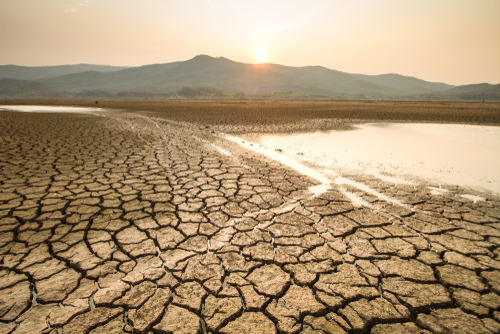It seems as if we have been here before. But for some reason, this time it’s different—it is worse. So much so that it looks and feels as if we are headed for a real game-changer.
I am referring to the drought now in California and many parts of the western United States. This year’s drought may be one of the worst on record, if not the worst on record. For example, on June 15, 2021, temperatures in Salt Lake City reached 107 degrees F. Only three times in the past 147 years has it gotten that hot.

At about the same time, Billings, Montana, hit 108 degrees F and Tucson and Phoenix both had record heat—higher than 115 degrees F—for five days. And in the Los Angeles area, natural vegetation is drying out about four months ahead of schedule due to the heat and lack of precipitation.
And there is more. It is estimated that more than two-thirds of the western U.S. is now in varying degrees of drought, the most expansive in drought history. The three largest reservoirs in the country—Lake Oroville, Lake Mead, and Lake Powell—are now grappling with water levels so low that their hydropower generation may decrease or shut down entirely in the next four months.
Yes, it appears the next few months will be exceedingly difficult for large portions of the country. Heat and lack of rainfall will change many lifestyles, food production may be reduced, business operations stymied, and likely the operation of facilities in California, the western U.S., and throughout the country will be impacted.
But why is this a game-changer? Because more and more people are finally accepting the fact that this is climate change, it has been evolving for decades, it is not going away, and for facility owners and managers, changes are now needed to keep our facilities open and operating.
The ways to accomplish this are going to require far more than just looking for leaks. Yes, billions of gallons of water are lost each year due to leaks. But we need to look at the bigger picture and determine where water is being used in our facilities and where it can be reduced or eliminated.
This requires conducting what is called a professional water audit.
In the past, water audits could often be undertaken in-house by engineers and building operations staffers. That still is possible if it is a small facility. However, today, because of the seriousness of the situation and because this summer is on its way to being a game-changer due to heat and drought, facility managers are advised to hire an outside firm specializing in these water consumption audits.
To make sure we are all on the same page when it comes to water audits, here are a few things worth noting:
• Water audits are relatively new. They came into the picture in the 1980s in India and other places, which have had chronic water shortages for decades.
• Water audits are like auditing a financial statement: There are credits, which represent how much water is delivered into a facility, and debits, indicating where that water is used, lost, or wasted.
• Today’s water audits are conducted using rational, scientific methods; however, a water audit aims to express an opinion. Once a water audit has been completed, the opinion could be, for example, that the facility is using water efficiently, with minor loss or waste, or just the opposite. (As it applies to water, the term “efficiently” refers to a long-term reduction in water consumption.)
• Along with expressing an opinion, a well-conducted water audit will provide facility owners and managers with suggestions as to where water can be used more efficiently, where water is used the most in a facility, where the most water is lost in a facility, and what steps can be taken—in increments, if necessary—to reduce water consumption long-term.
• Finally, if the opinion of the water audit is that steps need to be taken to reduce consumption, the audit should also provide some type of return on investment (ROI) for taking those steps.

Let us explore the last two points a bit more closely. As to the previous point, ROI, the following scenario should help us explain what we mean:
• The audit determines that the facility’s HVAC system is not using water efficiently and should be replaced.
• Replacing the system will cost about $25,000.
• The new system will reduce water consumption by about 100,000 gallons of water per year.
• At current rates, $0.06 per gallon in this scenario, the water cost savings would be $6,000 per year.
• In this case, the return on the investment would be slightly over four years. If the new system is also more energy-efficient, the return could be even faster.
The other point that may need further clarification regards taking steps in increments. This typically refers to what steps can be taken now, at slight or moderate cost, and still make a noticeable difference in reducing consumption.
The next are steps that will cost more can be implemented over the next six to 12 months, but make an even more significant impact on improving water efficiency. The final step typically refers to more costly measures, such as replacing the HVAC system in the scenario above.
Because most of the water used in a facility is consumed in restrooms, very often, owners and managers start there. Installing aerators in faucets is fast and very inexpensive. This is a perfect starting point.
A suggested next step would be swapping out water-using with no-water urinals. This can make such a significant water reduction and potentially even postpone retrofitting restrooms with high-performing toilets for several months or years down the road.
Whatever the steps taken, what is most important is to act. If what we are experiencing now is truly a game-changer, then the longer we delay taking steps now, the more serious the repercussions for building owners and managers.
Klaus Reichardt is CEO and founder of Waterless Co. Inc., based in Vista, Calif. Reichardt founded the company in 1991 with the goal of establishing a new market segment in the plumbing fixture industry with water efficiency in mind. Reichardt is a frequent writer and presenter, discussing water conservation issues. He can be reached at klaus@waterless.com.
